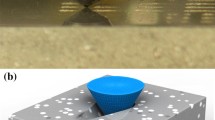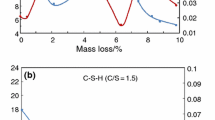Abstract
In this paper, the mechanical behavior of calcium–silicate–hydrate (C–S–H) and calcium–hydroxide (CH) was investigated at the nano-level. This study aims to propose a new method of evaluating nano-mechanical behavior of the two main cement paste components of C–S–H and CH. Nano-mechanical behavior of cement paste components is assessed, utilizing novel peak-force tapping mode of atomic force microscope and new proposed technique of elevated peak-forces. Another aim of this study is to investigate the early age properties of cement during the initial setting time by atomic force microscope. As a result, it is indicated that mostly C–S–H colloids treated as ductile materials comparing to brittle behavior of CH mono-layer sheet. However, multilayer of CH behaves like semi-ductile and plastic materials in very small increments of deflection. It was found that the trend of Young’s modulus is divided to three major intervals. Preliminary, the values were decreased within 20 min after the beginning of hydration and then it seems to be constant up to about 45 min after hydration (the initial setting time of cement). After that, Young’s modulus gradually increased up to 2 h after hydration to a relatively higher value. The roughness trend can be divided into three different phases as well as the Derjaguin, Müller, and Toporov modulus. First, at early 10 min, the values are increased drastically. Second, the average values are decreased sharply at 20 min after hydration and also reduced gradually up to around 60 min after hydration.







Similar content being viewed by others
References
Dilbas H, Çakır Ö, Şimşek M (2016) Recycled aggregate concretes (RACs) for structural use: an evaluation on elasticity modulus and energy capacities. Int J Civ Eng 1–15. doi:10.1007/s40999-016-0077-3
Mehta PK, Monteiro PJ (2006) Concrete—microstructure properties and materials. McGrawHill, New York
Butt HJ, Cappella B, Kappl M (2005) Force measurements with the atomic force microscope: technique, interpretation and applications. Surf Sci Rep 59:1–152
Lomboy G, Sundararajan S, Wang K, Subramaniam S (2011) A test method for determining adhesion forces and hamaker constants of cementitious materials using atomic force microscopy. Cem Concr Res 41:1157–1166
Sarıdemir M, Severcan MH, Çiflikli M, Çelikten S (2016) Microstructural analyses of high strength concretes containing metakaolin at high temperatures. Int J Civ Eng 1–13. doi:10.1007/s40999-016-0081-7
Peled A, Weiss J (2011) Hydrated cement paste constituents observed with atomic force and lateral force microscopy. Constr Build Mater 25:4299–4302
Peled A, Castro J, Weiss WJ (2013) Atomic force and lateral force microscopy (AFM and LFM) examinations of cement and cement hydration products. Cem Concr Compos 36:48–55
Jones ChA, Grasley ZC, Ohlhausen JA (2012) Measurement of elastic properties of calcium silicate hydrate with atomic force microscopy. Cem Concr Compos 34:468–477
Trtik P, Kaufmann J, Volz U (2012) On the use of peak-force tapping atomic force microscopy for quantification of the local elastic modulus in hardened cement paste. Cem Concr Res 42:215–221
Ferrari L, Kaufmann J, Winnefeld F, Plank J (2012) Reaction of clinker surfaces investigated with atomic force microscopy. Constr Build Mater 35:92–96
Taylor HFW (1997) Cement chemistry, 2nd edn. Thomas Telford Publishing, London
Yang T, Keller B, Magyari E (2002) AFM investigation of cement paste in humid air at different relative humidities. J Phys D Appl Phys 35:25–28
Trtik P, Kaufmann J, Volz U (2012) On the use of peak-force tapping atomic force microscopy for quantification of the local elastic modulus in hardened cement paste. Cem Concr Res 42(1):215–221
Jones CA, Grasley ZC, Ohlhausen JA (2012) Measurement of elastic properties of calcium silicate hydrate with atomic force microscopy. Cem Concr Compos 34(4):468–477
Gartner EM, Young JF, Damidot DA, Jawed I (2002) Hydration of Portland cement. In: Bensted J, Barnes P (eds) Structure and performance of cements. Spon Press, London
Hosten C, Avsar C (1998) Grindability of mixtures of cement clinker and trass. Cement and Concrete Res. 28:1519–1524
Plassard C, Lesniewska E, Pochard I, Nonat A (2005) Nanoscale experimentation investigation of particle interactions at the origin of the cohesion of cement. Langmuir 21:7263–7270
Derjaguin BV, Muller VM, Toporov YP (1995) Effect of contact deformation on the adhesion of particles. J Colloid Interface Sci 53(2):314–320
Sader JE, Chon JWM, Mulvaney P (1999) Calibration of rectangular atomic force microscope cantilevers. Rev Sci Instrum 70:3967
Acknowledgements
We want to express our sincere gratitude to Max Planck Institute for Polymer Research for providing an opportunity and grant to do our work on adhesion force in cement paste.
Author information
Authors and Affiliations
Corresponding author
Ethics declarations
Funding
Funding was provided by Max Planck Institute for Polymer Research.
Rights and permissions
About this article
Cite this article
Asgari, H., Ramezanianpour, A.A. & Butt, H.J. Nano-mechanical Behavior of Calcium Silicate Hydrate and Calcium Hydroxide in Cement Paste: Elevated Peak-Force Study. Int J Civ Eng 16, 273–280 (2018). https://doi.org/10.1007/s40999-016-0125-z
Received:
Revised:
Accepted:
Published:
Issue Date:
DOI: https://doi.org/10.1007/s40999-016-0125-z




